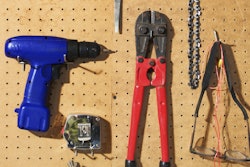
You want to guess at one cost that just about every company in the construction industry experiences? Having employees who are spending hours a week “Looking for stuff!” Yes, that’s right… “Stuff!” What kind of stuff, you ask? Well, stuff such as:
- Job information
- Contact cell numbers
- Local material plants
- Misplaced tools
- Parts for equipment “that I know was here…last year”
- Directions to the job site
- YOU…. the boss!
You name it and someone in your organization has probably looked for it. Stuff can be a person, place or thing Stuff isn’t biased or prejudiced about who experiences it and what they might be looking for…it’s just “stuff.” How much time on average is spent “looking for stuff?” Try about 90-minutes PER DAY! That’s right, one and one half hours per day…per employee.
So what’s the financial cost to your organization? Well, let me present an example of the impact of “looking for stuff” for a company of 50 employees.
Example
Lost Construction Company Inc. – 50 Employees
50 Employees x 1.5 hr/day =
75 Man Hours/Day (mhrs/d)
75 mhrs/d x 5 days/week =
375 mhrs/week
375 mhrs/week x 4 weeks/month =
1,500 mhrs/month
1,500 mhrs/month x 12 months/year =
18,000 mhrs/yr
Can you believe that? For a mere 90 minutes a day, on average, of 50 employees “looking for stuff,” that annualizes to about 18,000 hours spent, by our workers, “looking for STUFF!”
Consider the following question:
Using the average size job you completed last year, how many man hours were normally expended to complete such a job? If you’re average size project required, let’s say, 300 total man hours, eliminating “looking for stuff” would be like adding another 60 projects of the same average size to your books!
Let’s look at this from another angle…the financial perspective.
Let’s take those 18,000 man-hours and multiply this by your average “fully burdened” hourly rate. Let’s say that the average fully burdened labor rate for the Lost Construction Company is about $45 per man-hour. Consider the math for this reality:
18,000 total man-hours x $45/average hourly rate = $810,000
This last figure represents what the Lost Construction Company would have paid out for the entire year had their workers averaged 90 minutes per day of “looking for stuff.” That $810,000 represents pure profit my friend!
Now, you may be thinking, “Hey, wait a minute Humphrey! My workers are not nearly that disorganized. They might spend half that amount.” Ok, great, so take half of the total dollars paid out for a 50-employee company and you still spent about $405,000 in one year (still lost profit). Now apply this to your own organization and “do the math.” No matter whether you company consists of 10, 100 or 1,000 employees the cost can be a real dart that pops your profitability balloon.
“Looking for stuff” is a slippery villain to any construction company. It quietly sneaks up on contractors before they notice the impact made — and when they do try to react to correct the problem it can be difficult to even know where to begin. Therefore, let’s turn our attention to some prevention thinking before this organizational “disease” infects your company.
I’ll address the first two prevention-focused techniques in this article and address the remaining techniques in a future article.
“Looking for Stuff” Prevention
- Organize your yard, shop/tool room, gang box & trucks
- Conduct job information meetings (JIMs)
- Develop job set-up processes
- Develop check-sheets for inventory management
- Develop “next week look-aheads”
- Require daily crew huddles (AM & PM)
Ok, here we go!
Organize your yard, shop/tool room, gang box, & trucks
Your first effort should be to take a good look at all of the traditional areas that cry out for organization. This most often includes areas such as your yard where vehicles and equipment are parked and stored; your shop or tool room where important tools and components such as nails, brackets, belts, etc. are kept; a “gang box” where tools might be kept on the jobsite; and of course, your trucks.
Any area that might ever be a holding area needs to have a well-drawn schematic or drawing that looks down on the area from above — an overhead drawing. Details in the drawing should indicate where every item is to be kept when it is back at its “home base.” The completed drawing should then be laminated and posted in easy-to-see areas. The placement of such drawings then serves as a visual reminder to every employee where a particular tool, piece of equipment or component is to be found when needed and where the same is to be returned.
The quality movement that moved into our industry some 20 or so years ago introduced us to many of the organizational tools that the Japanese automotive industry created. Such tools have been integrated into just about every industry known to man. One of the “tools” of quality that Japanese efforts on quality produced is called the “5-S” map. For our purposes in construction, what was described in the previous two paragraphs very much embraces the 5-S technique.
Call your drawings what you will, just be sure to make this very easy effort practical and implement ASAP. Every time one of your workers complains that he cannot find a particular tool or needed component (i.e. like extra cotter pins, saw blades, gas can, trowel, etc.) consider whether or not you have a “5-S Map.” If you do, are the maps placed to yield the best results? If you don’t, what are you waiting for?
Conduct job information meetings (JIMs)
No matter the size of a job, every project needs a “pre-job information meeting (JIM).” The JIM is your crew’s opportunity to see the project on paper, talk about needs and expectations of the customer, discuss insights already made by your estimator on the job, and allows for questions to be addressed before you start the work.
Now, if you’re not a contractor that works on big and long-term projects, you might think that this “Looking for Stuff Prevention” technique is not really applicable to you. And I would say in a brief way, “You’re wrong! Dead wrong!” Why?
For the contractor who does projects smaller in size or works on multiple projects daily or weekly, the loss from “looking for stuff” can steal every dollar of profit you might have estimated. While your size of scope might be small and while you might look at completing several projects during the course of the week, you still benefit greatly by conducting your JIM at the first part of your workweek — with the discussion to include a brief presentation of all the projects that will be executed by your crews for that week. Perhaps a different application but the same process can work just as nicely for you!
Let’s consider a potential agenda for your JIM.
- Brief overview of project
- Highlights of known project challenges
- Customer expectations that are known
- Discussion about process order
- Discussion about needed equipment, tools, etc. (and where such items will be located)
- Role assignment of crew members
- Job facts including date start/end
- Discussion of safety issues, emergency info, etc.
- Time for Q&A with project team
- Positive charge & setting of goals
Now, if your project is more than one week in duration, should you hold the JIM at the beginning of each new week? Great question! First of all, while you might not conduct a JIM each new week covering all of the same ten agenda items listed above, you would be wise to integrate many of the same components at the start of each new week of project work. As many field leaders know, roles can change, different equipment might be needed some weeks, and customer change-orders can alter the direction that was initially understood and planned for by the crew.
Again, call the JIM by any name you want (maybe a DAVE?) but commit to beginning each and every new project with some variation of the agenda presented earlier. You’ll find much less confusion, more confidence among your team, and a lot less “looking for stuff” as more of your workers will have greater insight into the needs of the job and where important items are kept and maintained.
As you determine to reduce the negative impact made by your employees “looking for stuff” start first by incorporating these two techniques presented in this article. Remember, time spent “looking for stuff” is lost time; it can never be recaptured. And just in case you thought that your field worker was the only employee “looking for stuff” consider that the average time spent by office workers — even managers and owners — “looking for stuff” is closer to 2 to 2.5 hours per day. Ever spent time looking for that e-mail that customer or supplier said they sent you?
Looking for stuff is not a funny game. It’s a real thief of time, valuable production time that can cost you thousands of dollars, maybe hundred of thousands of dollars, every year. But there is a remedy to prevent such wasteful spending. Start today with the first two techniques and begin to put more money to your bottom line!




















